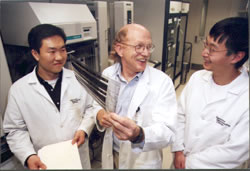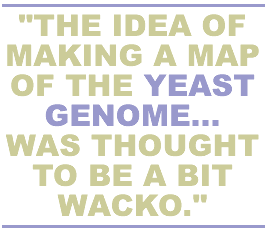
"He would spellbind us every day," Waterston says. "And this was the first summer he was talking publicly about his C. elegans work."
C. elegans is the Latin name of a tiny nematode worm that scientists study for its biological parallels to humans. Among other things, a lot can be learned about muscle from studying C. elegans. This worm would turn into an obsession for the new doctor.
In 1972, Waterston graduated with a rare commodity: separate but simultaneous M.D. and Ph.D. degrees. After graduation, Waterston went to England for postdoctoral studies with Brenner and his worm.
Four years later, Waterston joined the faculty at Washington University in St. Louis. Already interested in genetics, he served on a committee that recruited a young geneticist, Maynard Olson.

Bob Waterston jokes with two research assistants. Photo courtesy Washington University in St. Louis.
"I was already interested in the idea of making a map of the yeast genome, which at the time was thought to be a bit whacko-but Bob was very interested," Olson recalls.
In the early '80s, Olson proved that his ideas weren't so "whacko." He created a physical map of the yeast genome by cloning overlapping fragments of DNA. His team invented revolutionary methods to do the work-methods that later served as an underpinning of the Human Genome Project itself.
Meanwhile, Waterston developed a successful laboratory in muscle research studying his nematode worm. He later went back to England with the goal of finding a new class of muscle genes. Once again, fate played a role. The traditional worm group did not have space for him, so they found him a space with John Sulston-now Sir John Sulston, and a winner with Brenner and Robert Horvitz of the 2002 Nobel Prize in Medicine. When Waterston arrived, Sulston was immersed in genome studies of C. elegans.

Waterston saw that Sulston had problems cloning the worm's DNA and remembered that Olson's lab in St. Louis had an answer. So he began working on Sulston's project. When he returned to St. Louis, Waterston began applying Olson's answer to Sulston's problem. The results were excellent, and Waterston was now fully off on another track. Besides becoming a muscle scientist, he was now a genome scientist.
That was not such an obvious choice back in the 1980s, when DNA analysis was far more tedious and laborious than it is today. It represented a deliberate risk for someone who was already a successful muscle researcher. Some scientists debunked the effort to capture the human being's genetic code. One letter to the editor in Nature said the idea was like trying "to excavate the entire country of Kenya to a uniform depth of six meters (to look for) for hominid fossils" and concluded that "any biologists who proposed such projects would doubtless be obliged to carry them out in a padded laboratory."
Padding was not necessary for the laboratories where Sulston, Waterston and another English collaborator, Alan Coulson, labored to produce a complete physical map of the worm's six chromosomes. In 1989, at a gathering of worm researchers, Coulson taped up a map of the worm genome that stretched along the back of the auditorium. The map ran about 40 sheets wide-held together by Scotch tape-with six rows, one row for each chromosome. The map represented an organism whose genome-the length of all its chromosomes-is 97 million base pairs of DNA.